Let me structure this carefully to ensure each idea is unique and covers different materials, styles, and approaches.Creating a beautiful and functional garden path enhances both the aesthetic appeal and practicality of your outdoor space. Garden paths serve as vital connections between different areas of your yard, guiding visitors through your landscape while protecting your lawn from foot traffic. The right path material and design can transform an ordinary garden into an extraordinary retreat, whether you prefer the natural charm of stepping stones, the classic elegance of brick, or the rustic appeal of gravel. From budget-friendly mulch paths to sophisticated herringbone patterns, the possibilities are endless. Each path type offers unique benefits in terms of maintenance, durability, and visual impact. Consider your garden's style, climate, and intended use when selecting the perfect path design that will complement your landscape for years to come.
1. Natural Stone Stepping Stone Garden Path
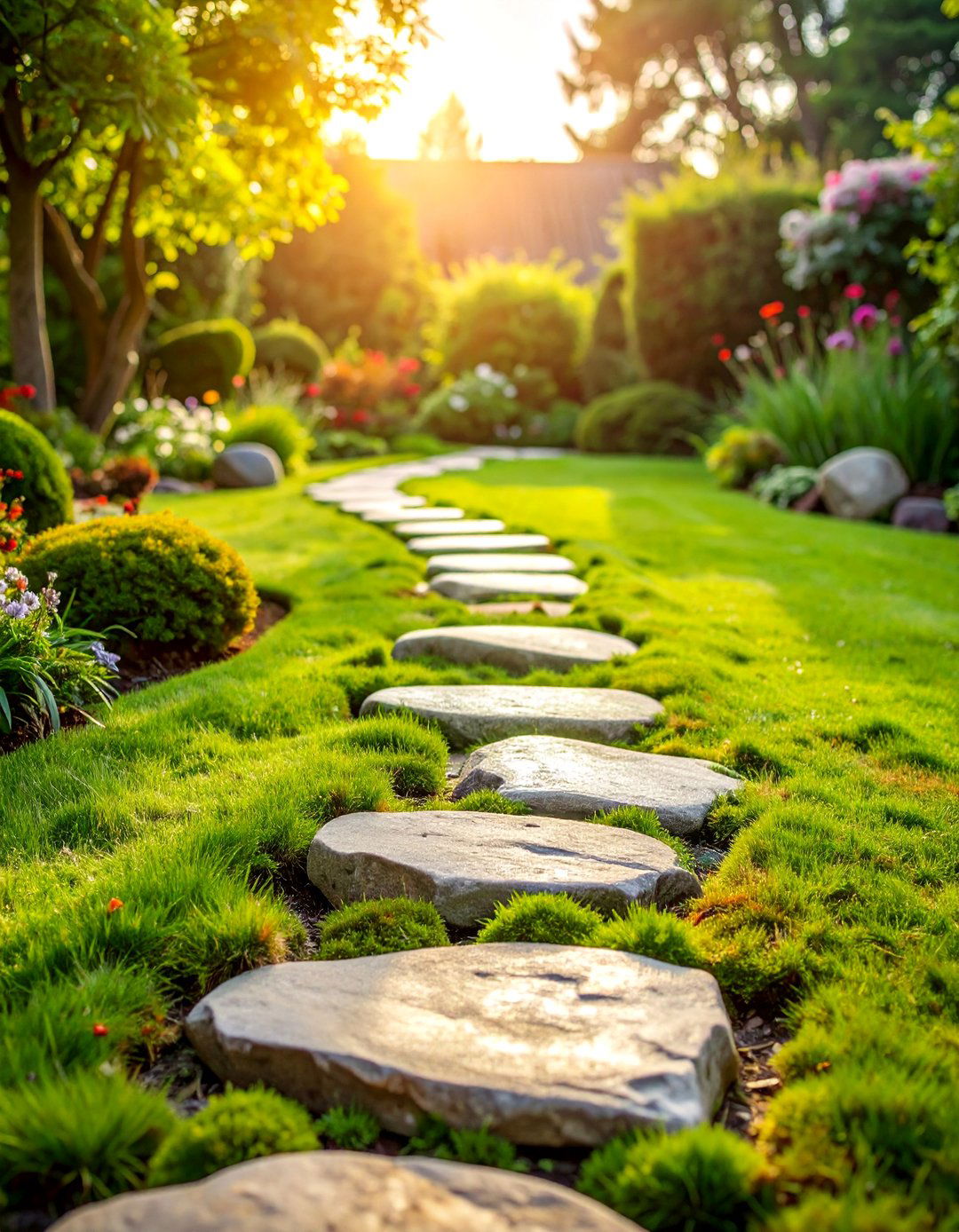
Creating a natural stone stepping stone garden path offers an organic and timeless approach to landscape design. Natural stones like limestone, granite, and sandstone provide exceptional durability and exquisite appearance, making them perfect for high-traffic areas. These stepping stones can be arranged in intricate patterns to add depth and interest to your walkway, whether you choose large irregular stones for a rustic feel or precisely cut pieces for a more formal look. The spacing between stones allows for creative landscaping opportunities, such as planting low-growing ground covers like moss or creeping thyme. Stepping stones should generally be placed 18-24 inches apart to allow comfortable walking. This type of garden path works exceptionally well in cottage gardens, woodland settings, or any landscape where you want to maintain a natural, unstructured appearance while providing safe passage.
2. Gravel Garden Path with Decorative Edging
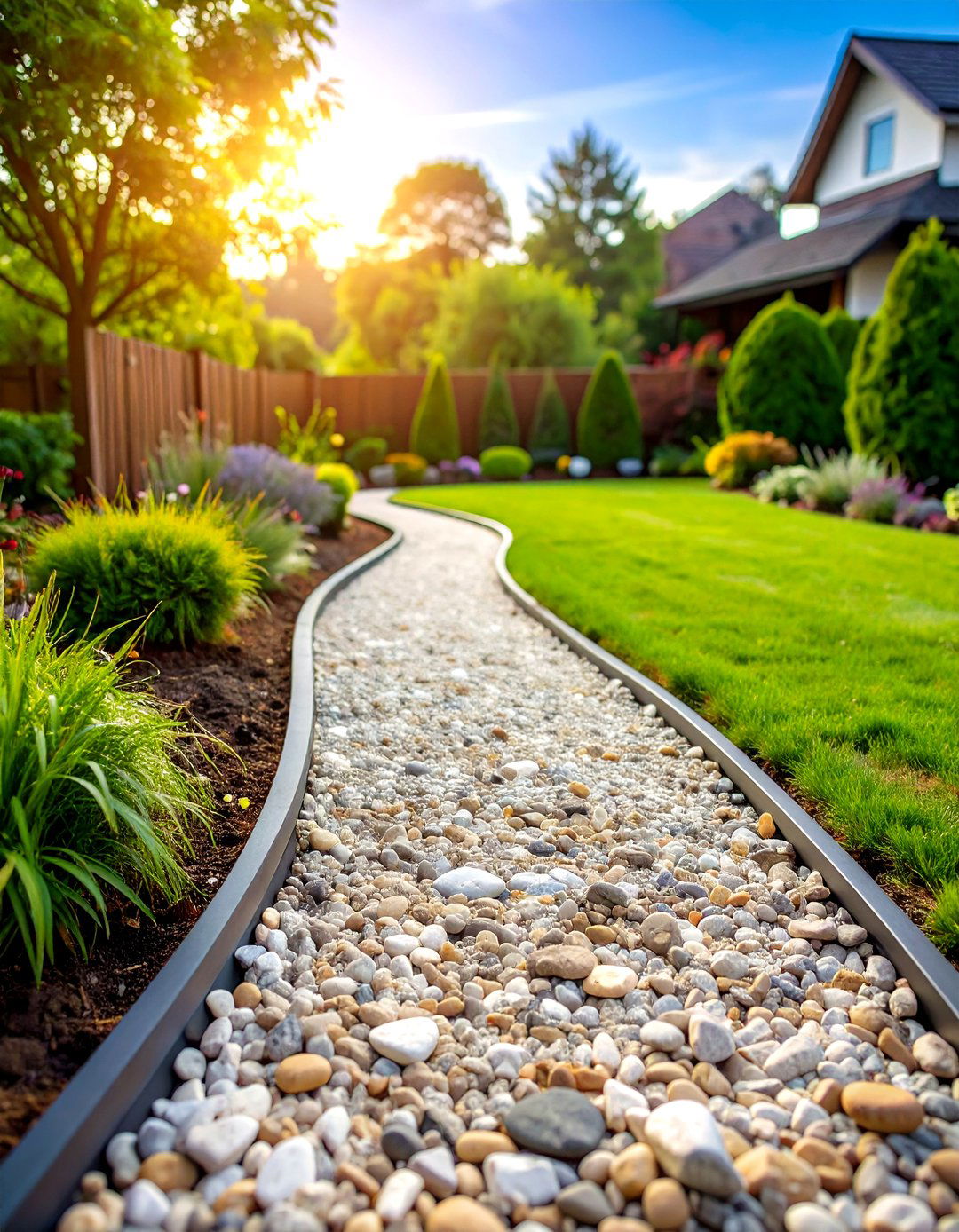
Gravel represents one of the most cost-effective and versatile materials for creating attractive garden paths. Gravel is usually sold by the ton and costs about the same as mulch for a path 3 inches deep and 3 feet wide. Gravel is a really cost-effective, natural material and is great as a permeable path surface, allowing water to drain naturally and preventing puddles. The key to a successful gravel garden path lies in proper edging - whether using steel, aluminum, brick, or stone borders to keep the material contained. Smaller stones, averaging under 1/2 inch, are best for paths because they offer more comfort underfoot and pack together better. Choose from various colors and textures, from warm honey tones to cool gray hues, to complement your garden's color scheme. Regular maintenance involves occasional raking to keep the surface level and weed removal, making it an excellent low-maintenance option for busy gardeners.
3. Herringbone Brick Garden Path Pattern
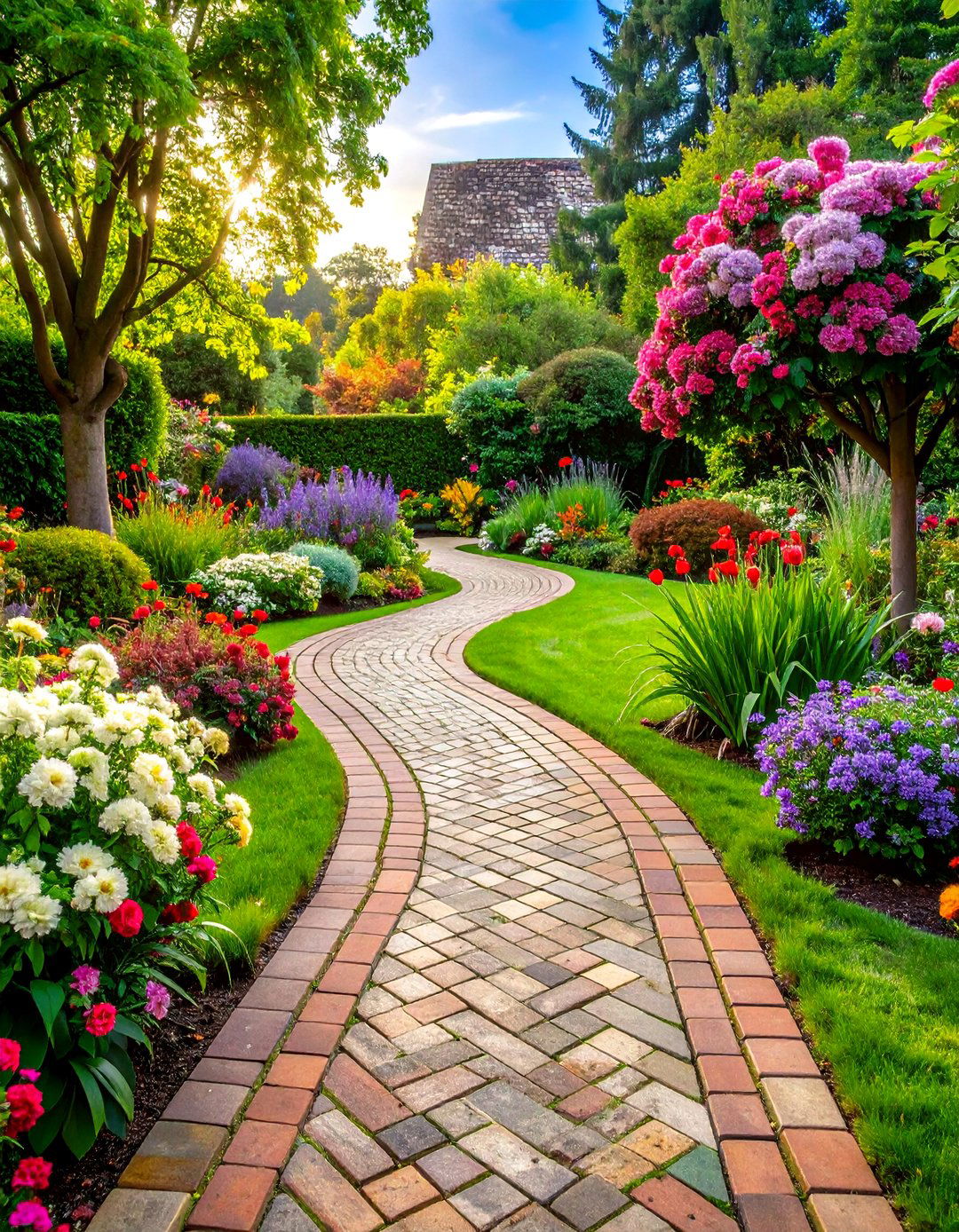
The herringbone brick garden path pattern represents classic elegance and structural integrity in landscape design. Herringbone paving is a classic and timeless method of arranging rectangular bricks to create a distinctive and visually appealing look that has been utilized since ancient civilizations. Herringbone is one of the most structurally sound patterns, with interlocking bricks that resist shifting under pressure, making it ideal for high-traffic walkways. Two popular angles define the herringbone layout: 45-degree herringbone points diagonally and suits square patios or formal garden paths, while 90-degree herringbone runs bricks straight in rows. This pattern creates visual movement and complexity, transforming even simple materials into sophisticated pathways. The interlocking design distributes weight evenly, ensuring long-lasting durability while requiring minimal maintenance beyond occasional sweeping and rare replacement of individual bricks.
4. Wooden Plank Garden Path Boardwalk

A wooden plank garden path boardwalk brings natural warmth and organic beauty to any landscape setting. Wood from pallets or simple reclaimed wood planks offer versatility and can enhance patios and garden shed areas, creating charming rustic pathways that complement natural surroundings. Wood plank garden paths offer the feel of a Japanese garden and can be customized easily for width, using materials like cedar decking boards, treated lumber, or recycled pallet wood depending on your desired aesthetic and budget. A wooden walkway makes an attractive and inexpensive garden path, is simpler and less backbreaking to make than stone or concrete paths, and works well in sloping or wet areas. The elevated design prevents wood from sitting directly on soil, reducing rot potential while providing excellent drainage. Maintenance involves power washing once or twice seasonally and applying protective stain as colors fade, ensuring decades of beautiful service.
5. Mulch Garden Path with Natural Edging
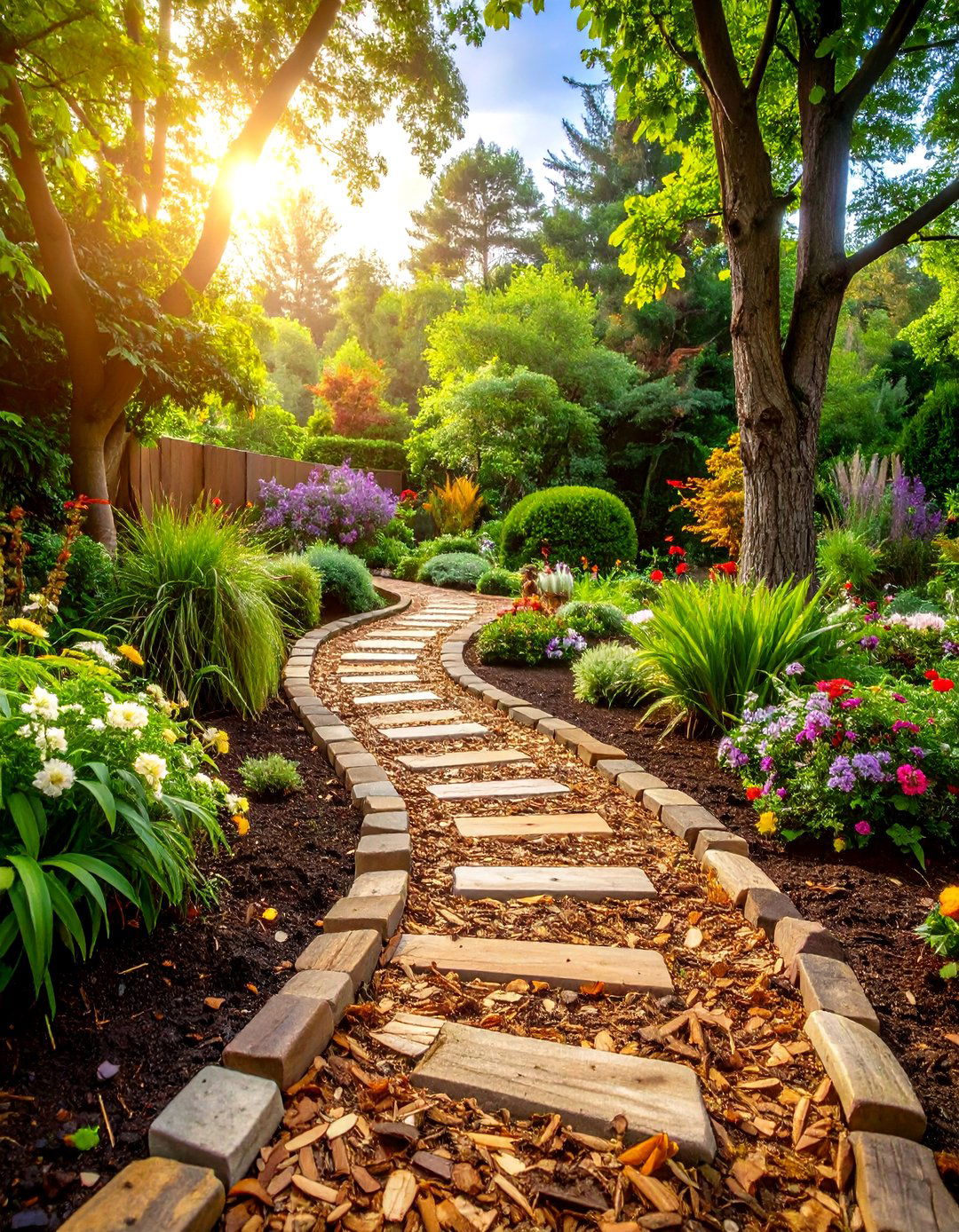
Mulch offers the most budget-friendly option for creating attractive garden paths while maintaining an organic, woodland appearance. The three common types of mulch suitable for garden paths are wood chips, cocoa bean, and cypress bark, and since these materials are lighter than stone, they're easier to haul and spread. Wood chips, gravel and stepping stones are great beginner-friendly landscaping materials for DIY garden paths that are soft underfoot but solid enough to handle heavy foot traffic or a loaded wheelbarrow. Natural edging using locally sourced stones or split logs keeps the mulch contained while creating a seamless transition with surrounding plantings. Mulch has an excellent natural, earthy feel, though the natural materials break down over time and require replacement. The decomposition process actually benefits surrounding plants by enriching soil as organic matter breaks down, making this an environmentally beneficial choice for eco-conscious gardeners.
6. Flagstone Garden Path with Moss Joints
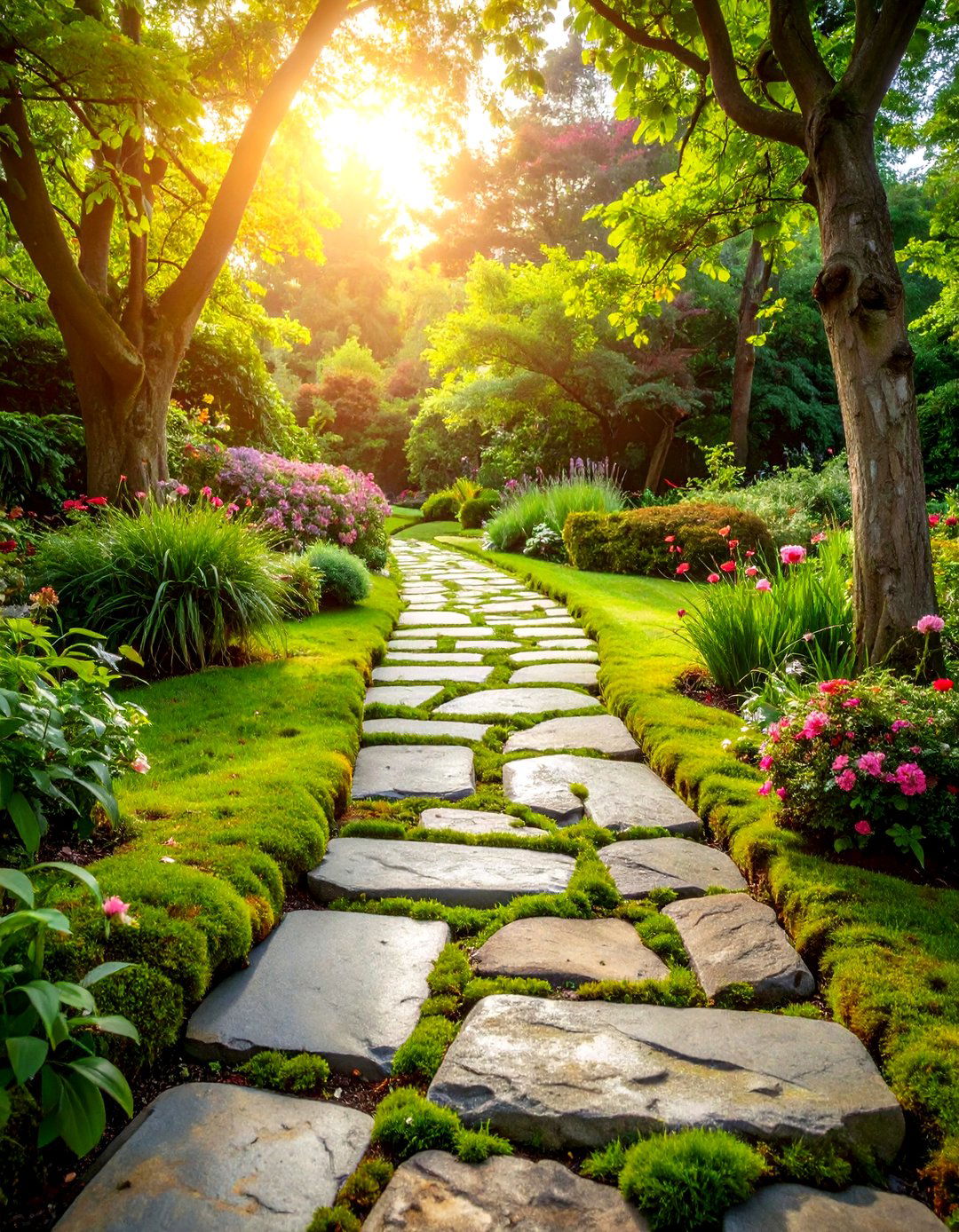
Flagstone creates stunning garden paths that blend formal sophistication with natural beauty through irregular shapes and varied textures. Flagstones are natural sheets of stones available in various colors and finishes that can be snapped or cut into various shapes and sizes, with popular choices including Connecticut Bluestone and Arizona Flagstone in Buff tones. Connecticut Bluestone is a classic East Coast paving stone that's been used for centuries, dating back to the 1800s, offering time-tested durability and elegance. The organic spacing between irregular flagstones provides perfect opportunities for moss growth, creating a romantic, fairy-tale atmosphere. Moss naturally establishes in the joints over time, requiring no maintenance while providing soft green contrasts against stone surfaces. Although flagstone requires higher initial investment compared to other materials, its exceptional durability and timeless beauty make it worthwhile for creating paths that improve with age and weather naturally into stunning landscape features.
7. Decomposed Granite Garden Path Design
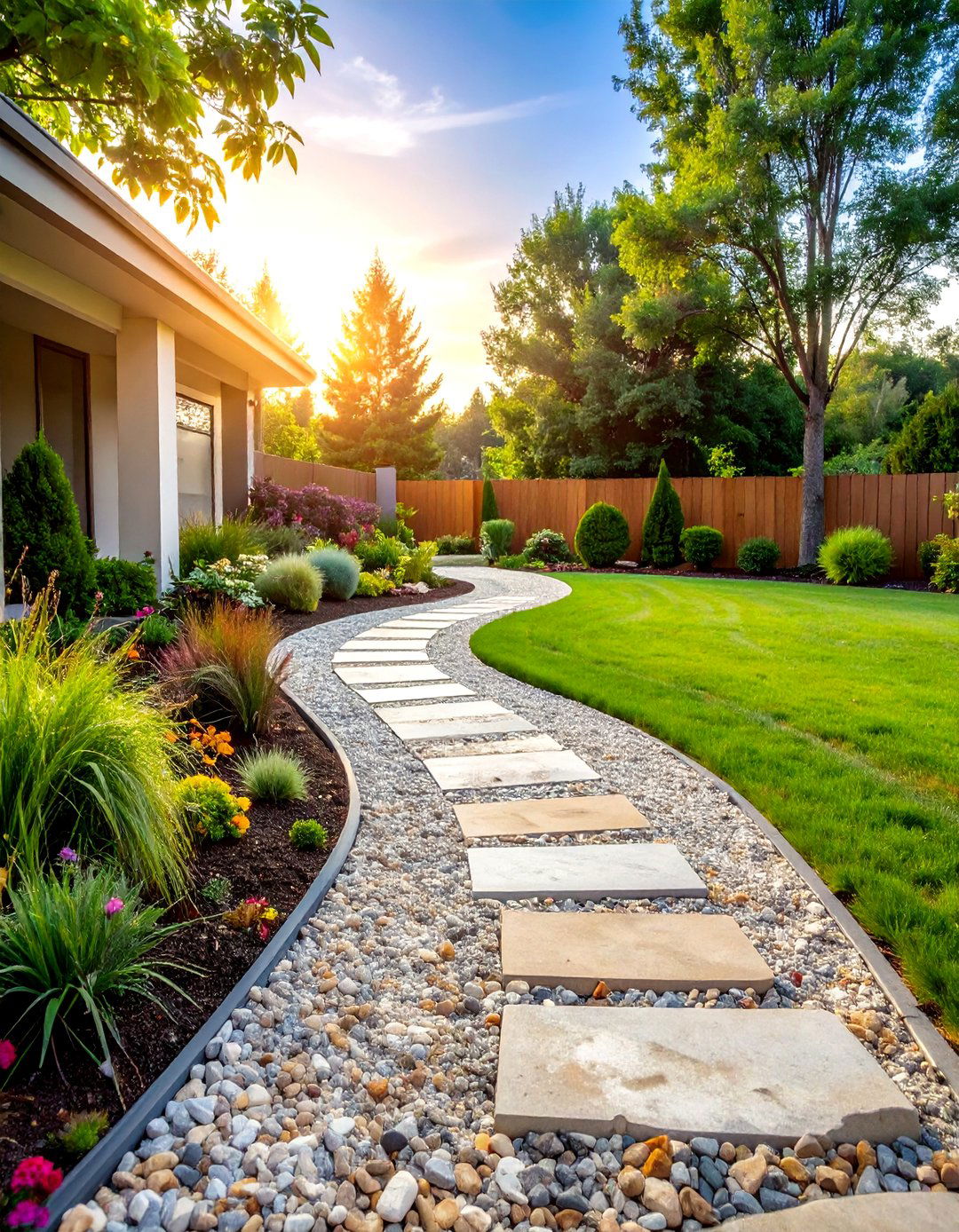
Decomposed granite offers a refined, contemporary alternative to traditional gravel that creates smooth, firm walking surfaces perfect for modern landscapes. Unlike loose gravel, decomposed granite compacts into a stable surface that feels solid underfoot while maintaining excellent drainage properties. Decomposed granite is one of the easiest and least expensive landscaping materials to create garden walkways, requiring minimal maintenance beyond occasional recompaction. The fine texture and neutral colors - ranging from golden honey to cool gray - complement both contemporary and traditional garden designs beautifully. Installation involves removing existing vegetation, laying landscape fabric, adding a gravel base, then spreading and compacting the decomposed granite in thin lifts. The result is a naturally porous surface that prevents water runoff while providing wheelchair accessibility and bicycle-friendly pathways. This material works exceptionally well in drought-tolerant gardens, Mediterranean landscapes, and modern minimalist designs where clean lines and subtle textures are desired.
8. Curved Brick Garden Path with Border

Designing a curved brick garden path with decorative borders creates visual intrigue while guiding visitors on a journey of discovery through your landscape. Curving a path through planting creates intrigue and allure, drawing you down the path further as you can't see what's round the next bend, encouraging exploration and creating mindful experiences. A curving path slows you down intentionally, so that you stop and notice what's new, what's in bud, what's growing, making travel through your garden a therapeutic experience. Craft an elegant curved gravel pathway bordered with brick edging, where the rich red-brown tones of the bricks beautifully complement natural hues. The gentle curves work particularly well in cottage gardens, informal landscapes, and areas where you want to soften harsh architectural lines. Proper planning ensures smooth curves that feel natural rather than forced, while brick borders provide clean definition and prevent lawn encroachment.
9. Pea Gravel Garden Path with Steel Edging
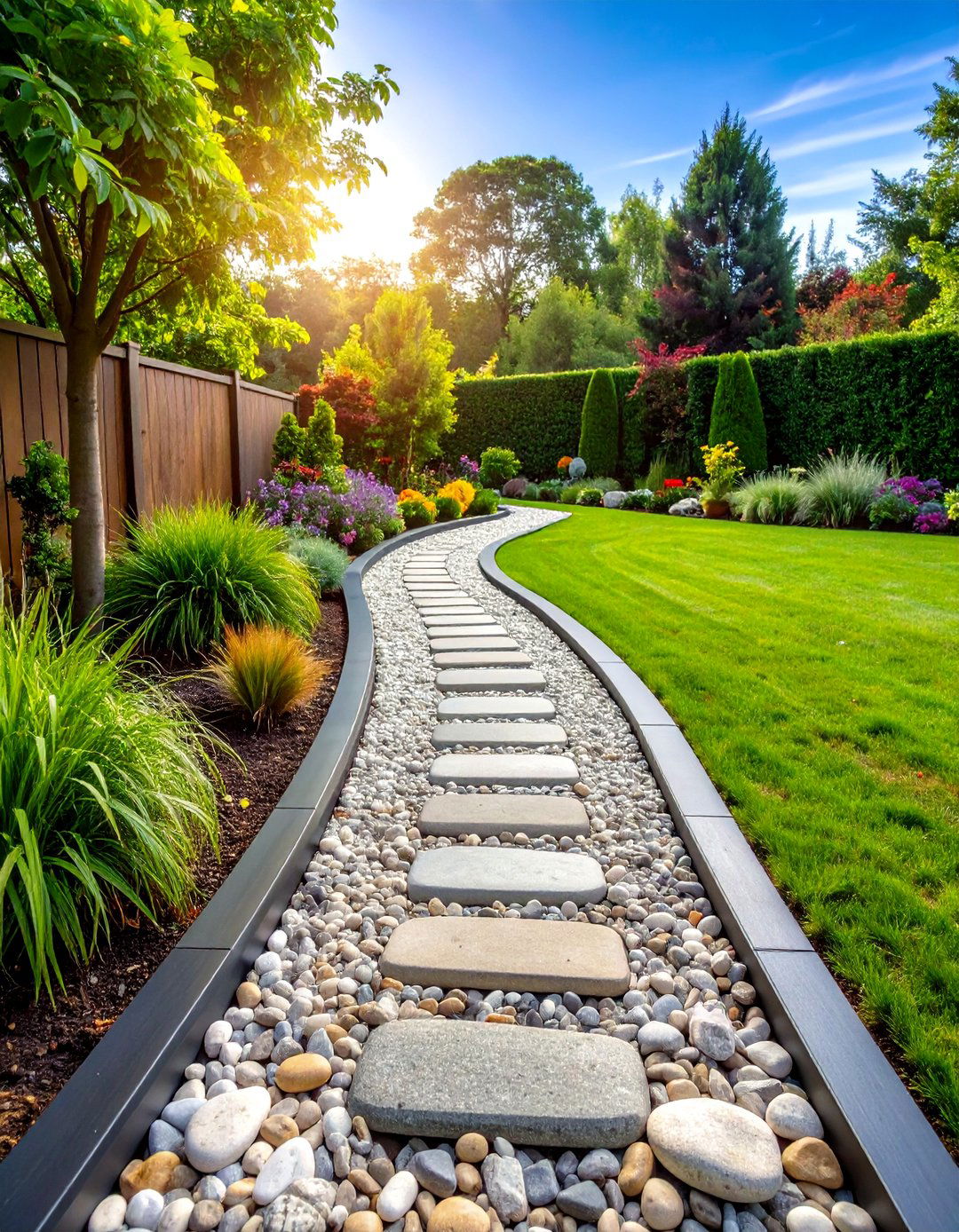
Pea gravel garden paths offer comfortable walking surfaces with excellent drainage characteristics that work beautifully in both formal and informal settings. Pea stone is popular for paths because it has been smoothed and rounded by moving water, making it easy to walk on, especially barefoot. The rounded stones provide a stable yet flexible surface that adapts to ground movement while remaining comfortable underfoot. Steel or aluminum edging creates crisp, contemporary lines that give paths a neat, professional appearance while effectively containing the gravel. Gravel preparation requires using a weed suppressing membrane with a hexagonal grid to help lock the gravel in place, ensuring long-term stability and reduced maintenance. Available in various sizes and colors, pea gravel can be selected to complement existing hardscaping materials. The natural drainage properties make this an excellent choice for areas with heavy rainfall or poor soil drainage, while the neutral colors work well with any garden color scheme.
10. Concrete Stepping Stone Garden Path

Concrete stepping stones provide unlimited design possibilities for creating custom garden paths that reflect your personal style and creativity. Pre-made concrete stepping stones such as Calstone or StepStone products can be an excellent option, while DIY stepping stones using concrete molds allow for personalized designs. Creating personalized stepping stones using concrete molds allows for shapes and incorporated designs such as mosaic patterns or leaves, giving you complete creative control over your pathway's appearance. The versatility of concrete allows for various finishes - from smooth, contemporary surfaces to textured, natural-looking stones that mimic quarried materials. You can embed decorative elements like glass pieces, shells, or leaf impressions during the casting process. Concrete can be inset with decorative details for added visual interest. Concrete stepping stones offer excellent durability at budget-friendly prices, making them perfect for families wanting to create personalized garden features that children can help design and install.
11. Mixed Material Garden Path Combination
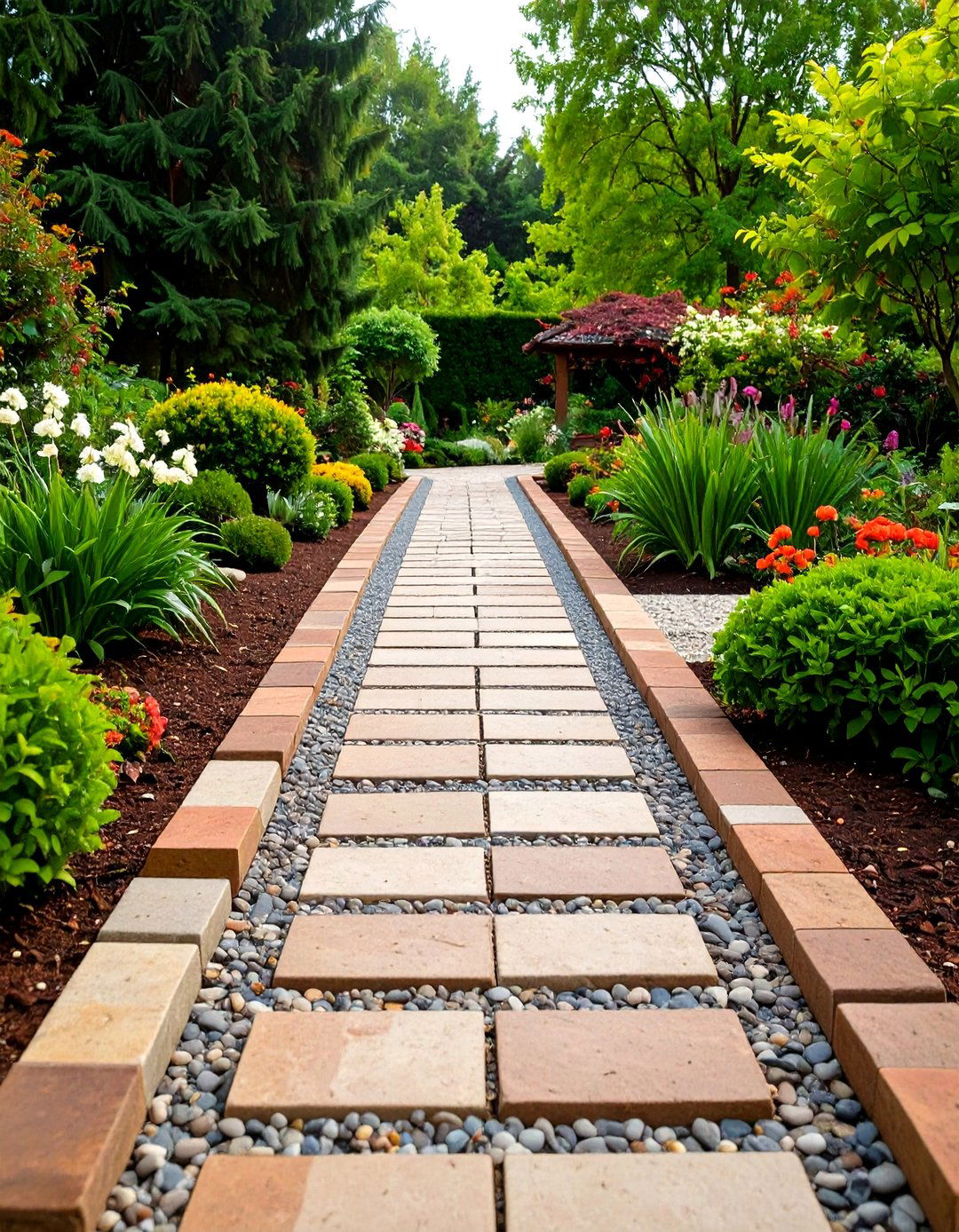
Combining different materials in garden path design creates dynamic visual interest while allowing you to optimize each material's strengths for specific sections. Combine two or three materials for a considered textural look in pathways, such as random brick pavers set into recycled aggregate. Mixing standard stepping stones with more expensive mosaic ones sprinkled in between saves money while dressing up mulch pathways. This approach allows you to use premium materials as accents while keeping overall costs manageable. Popular combinations include brick borders with gravel centers, wooden planks with stone accents, or flagstone stepping stones over decorative mulch. When perusing walkway ideas, consider how much you want to spend on materials, as flagstone or pavers are more expensive than gravel or bark. Mixed materials also provide practical benefits - using different textures can indicate direction changes, create rest areas, or highlight garden features. The key is limiting your palette to maintain cohesion while creating enough contrast to generate visual excitement.
12. Wood Slice Garden Path Natural Design

Wood slice garden paths embrace sustainable design principles while creating uniquely rustic pathways that celebrate natural materials and organic forms. A small wood slice garden path looks very natural and eco-friendly, and you can easily DIY such a walkway using fallen trees, pruned branches, or sustainably sourced timber. Tree trunk style stepping stones can transform your garden into a whimsical woodland wonderland, meandering through grassy lawns or amidst bark beds to evoke an enchanted woodland theme. The varying diameters of wood slices create organic, irregular spacing that feels completely natural in woodland gardens, cottage landscapes, or any setting where you want to emphasize connection with nature. In shady gardens, use bark woodchip with felled branches, split or cut logs to create paths in harmony with the environment. While wood slices eventually decompose, this process enriches surrounding soil and can be viewed as part of the garden's natural cycle. Regular maintenance involves replacing deteriorated pieces and adding fresh wood chips between slices.
13. Limestone Garden Path with Clean Lines
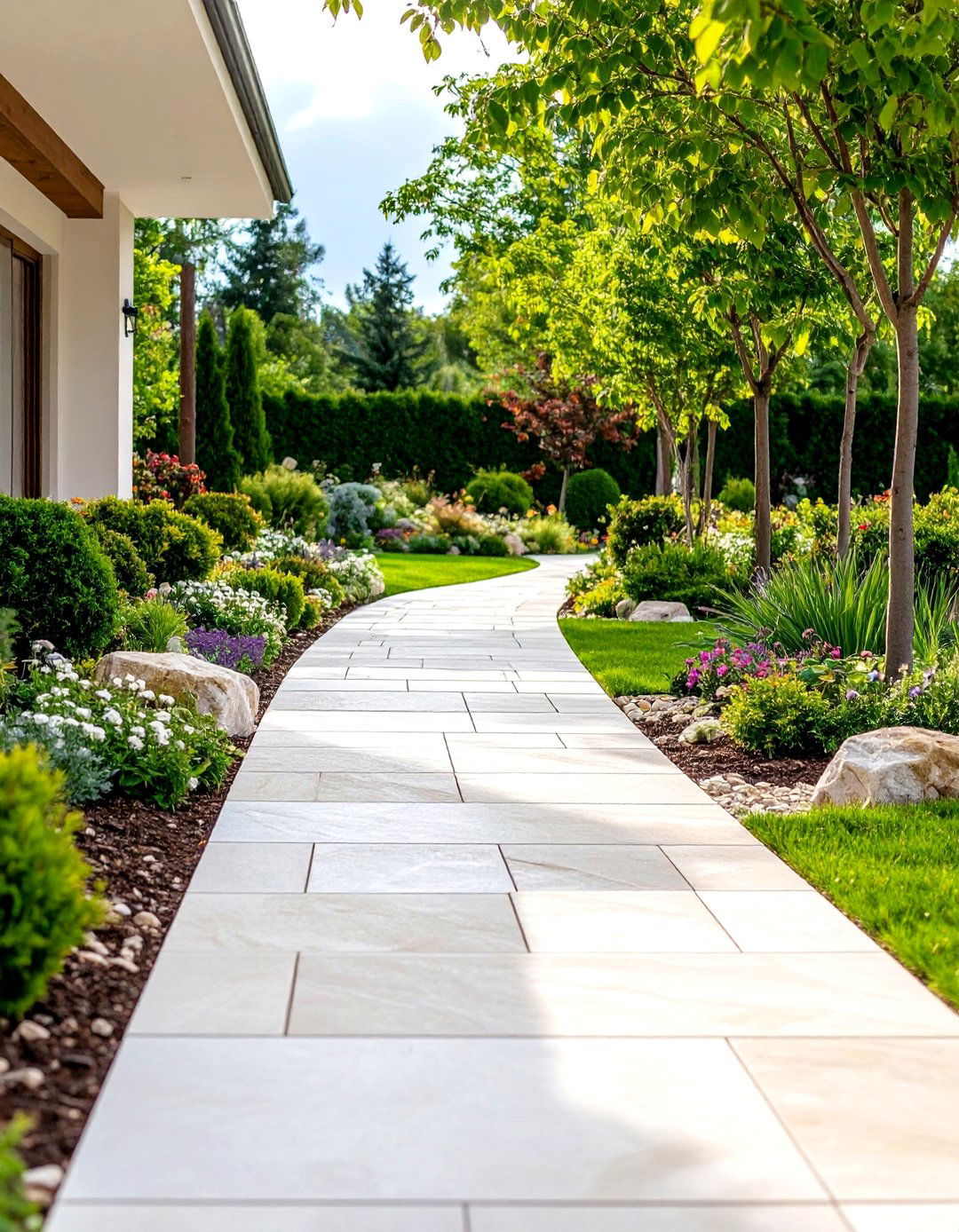
Limestone garden paths deliver sophisticated elegance through clean lines and refined surfaces that complement both traditional and contemporary architectural styles. Limestone is available as sawn cut in various colors and finishes, such as Salem Gold and Azure, and can be easily cut into custom shapes and sizes to suit unique landscape design preferences. With natural stone, you need to decide whether to use cut pavers for a smooth finish or riven pavers for more texture, allowing you to match the formality level of your overall design. The neutral colors of limestone - ranging from warm cream to cool gray - provide versatile backgrounds that highlight surrounding plantings without competing for attention. Limestone is a long-lasting and low-maintenance material, though it represents a premium investment compared to other pathway options. The smooth, consistent surfaces work excellently for wheelchairs and formal entertaining areas, while the natural stone appearance maintains organic appeal that synthetic materials cannot replicate.
14. Permeable Paver Garden Path System
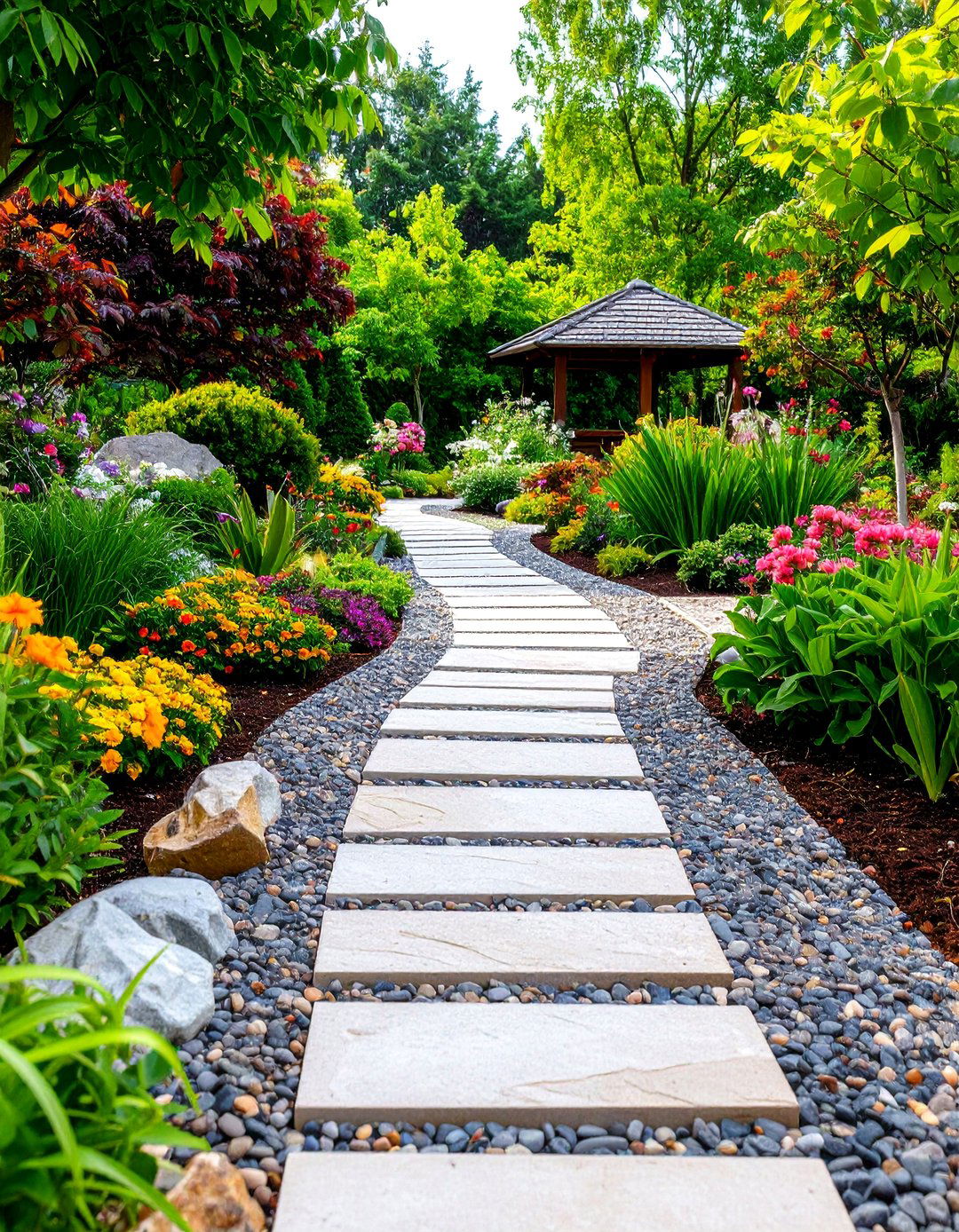
Permeable paver garden paths address environmental concerns while providing durable, attractive walking surfaces that manage stormwater runoff effectively. Permeable bricks reduce water runoff and are eco-friendly, allowing rainwater to infiltrate naturally rather than overwhelming storm drainage systems. These specialized pavers feature larger joints filled with gravel or grass that permit water penetration while maintaining structural integrity. The environmental benefits include reduced erosion, groundwater recharge, and decreased flooding risks during heavy rainfall events. Installation requires careful attention to proper base preparation and drainage considerations to ensure optimal performance. Available in various materials including concrete, clay brick, and natural stone, permeable pavers can match any architectural style. While initial costs may exceed traditional paving, the long-term environmental benefits and potential municipal incentives often offset higher upfront investments. Regular maintenance involves keeping joints clear of debris and occasional reapplication of joint materials to maintain permeability.
15. Checkerboard Pattern Garden Path Design
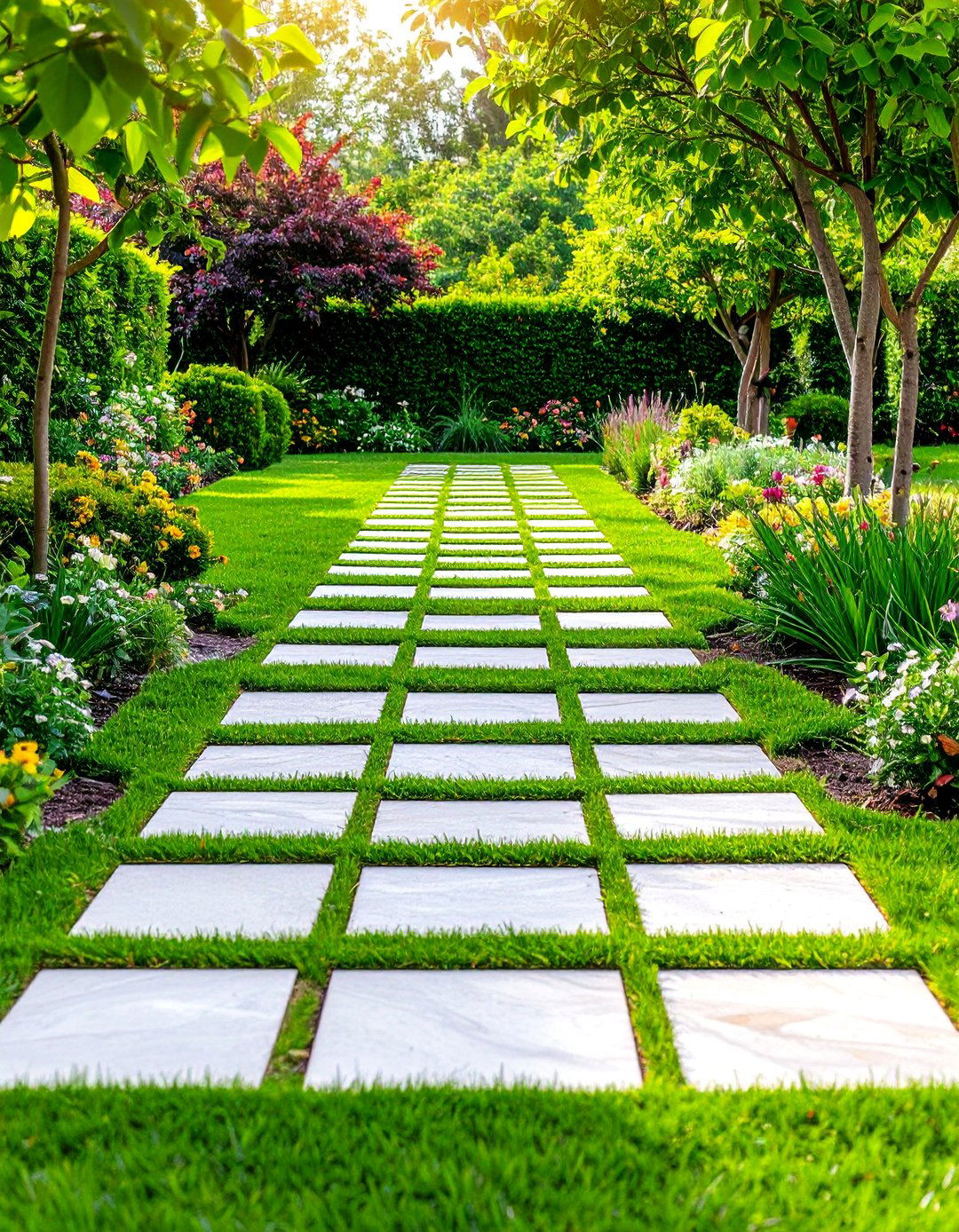
The checkerboard pattern garden path design creates striking visual impact through alternating materials that form geometric squares reminiscent of classic game boards. The checkerboard pattern involves placing paving stones in alternating squares with various herbs and ground covers planted in open spots, creating a smart approach that fills areas while reducing weed opportunities. This design works beautifully with alternating grass and stone squares, brick and gravel combinations, or contrasting stone colors. The geometric precision adds formal structure to cottage gardens while providing playful elements that children particularly enjoy. Planning requires careful measurement to ensure equal-sized squares that align properly throughout the pathway length. It's a smart way to fill an area while reducing the opportunity for weeds when living materials are incorporated between hard surfaces. The pattern scales well from narrow walkways to broader plaza areas, adapting to various space requirements while maintaining visual coherence through repetitive geometric elements.
16. Japanese-Inspired Garden Path with Bamboo

Japanese-inspired garden paths emphasize simplicity, natural materials, and mindful design principles that create tranquil spaces for contemplation and peaceful movement. Creating a Zen garden with stepping stones adds peaceful and tranquil ambiance, where natural stones such as round stones create harmonious and balanced aesthetic. The round shape of stones symbolizes harmony and unity, enhancing the Zen atmosphere and encouraging mindfulness and relaxation. Bamboo edging or decorative elements complement stone pathways while maintaining the essential minimalist aesthetic. These paths typically feature irregular natural stones with generous spacing filled with raked gravel, moss, or carefully selected plantings. The design philosophy emphasizes asymmetrical balance rather than formal symmetry, creating dynamic compositions that feel naturally evolved. Materials should appear weathered and organic, avoiding overly polished or manufactured appearances. Water features, carefully placed rocks, and selected evergreen plantings complete the serene atmosphere while providing year-round beauty.
17. Raised Wooden Garden Path Boardwalk

Raised wooden garden path boardwalks solve drainage problems while creating elevated walkways that protect both your feet and underlying landscape from wet conditions. During wet conditions, boardwalks provide much-needed pathways that keep feet dry while preventing soil compaction in garden beds. Building with wood is far less backbreaking than stone or concrete paths, requiring just a few holes to dig while hauling lighter materials. The elevation protects wood from ground moisture while creating interesting sight lines through garden plantings. Raised wooden pathways are comfortable and welcoming ideas for modern gardens that can be painted to match existing decking areas. Construction involves setting treated posts at regular intervals, adding support framing, then installing weather-resistant decking materials. The raised design works particularly well in boggy areas, sloped terrain, or anywhere you want to minimize landscape disturbance. Regular maintenance includes annual inspections, occasional board replacement, and refinishing every few years to maintain weather protection and appearance.
18. Mosaic Stone Garden Path Artistry
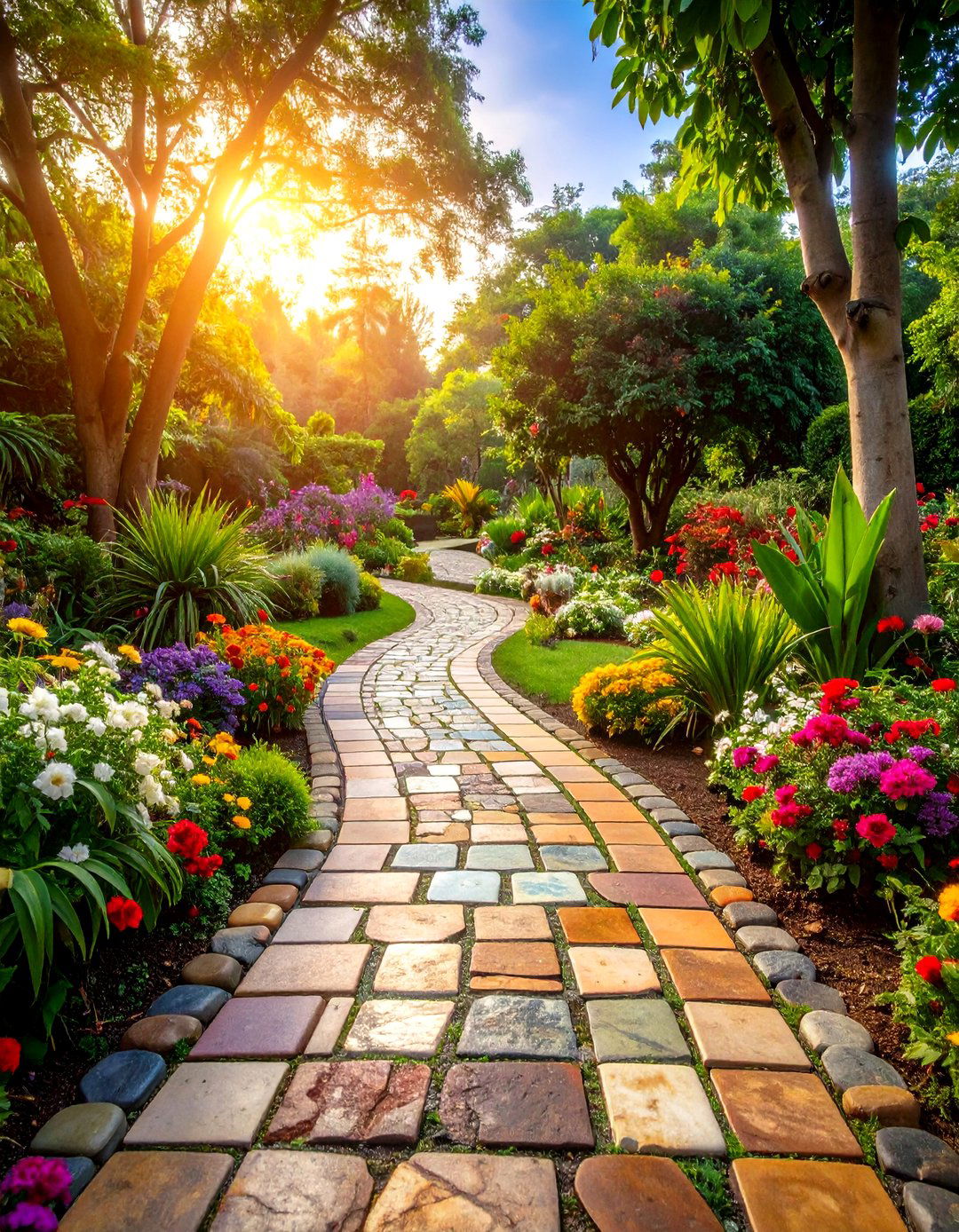
Mosaic stone garden paths transform functional walkways into artistic masterpieces through careful arrangement of colored stones, tiles, or pebbles in decorative patterns. Natural stones like river rocks can be arranged in intricate patterns to add depth and interest, creating stunning mosaic-like effects that impress visitors and provide unique focal points. Colorful stepping stones can be arranged in patterns and surrounded with larger rocks to create picturesque mosaic paths that showcase personal creativity and artistic vision. The technique involves creating base forms using concrete or mortar, then embedding stones in planned patterns that might include geometric designs, flowing curves, or representational images. Popular materials include tumbled glass, ceramic tiles, natural pebbles, and broken pottery arranged in flowing patterns or structured designs. While labor-intensive during installation, mosaic paths require minimal maintenance beyond occasional cleaning and rare repairs. The artistic investment creates permanent landscape features that appreciate in both beauty and value over time, making every walk through your garden a cultural experience.
19. Grass Garden Path with Mown Strips
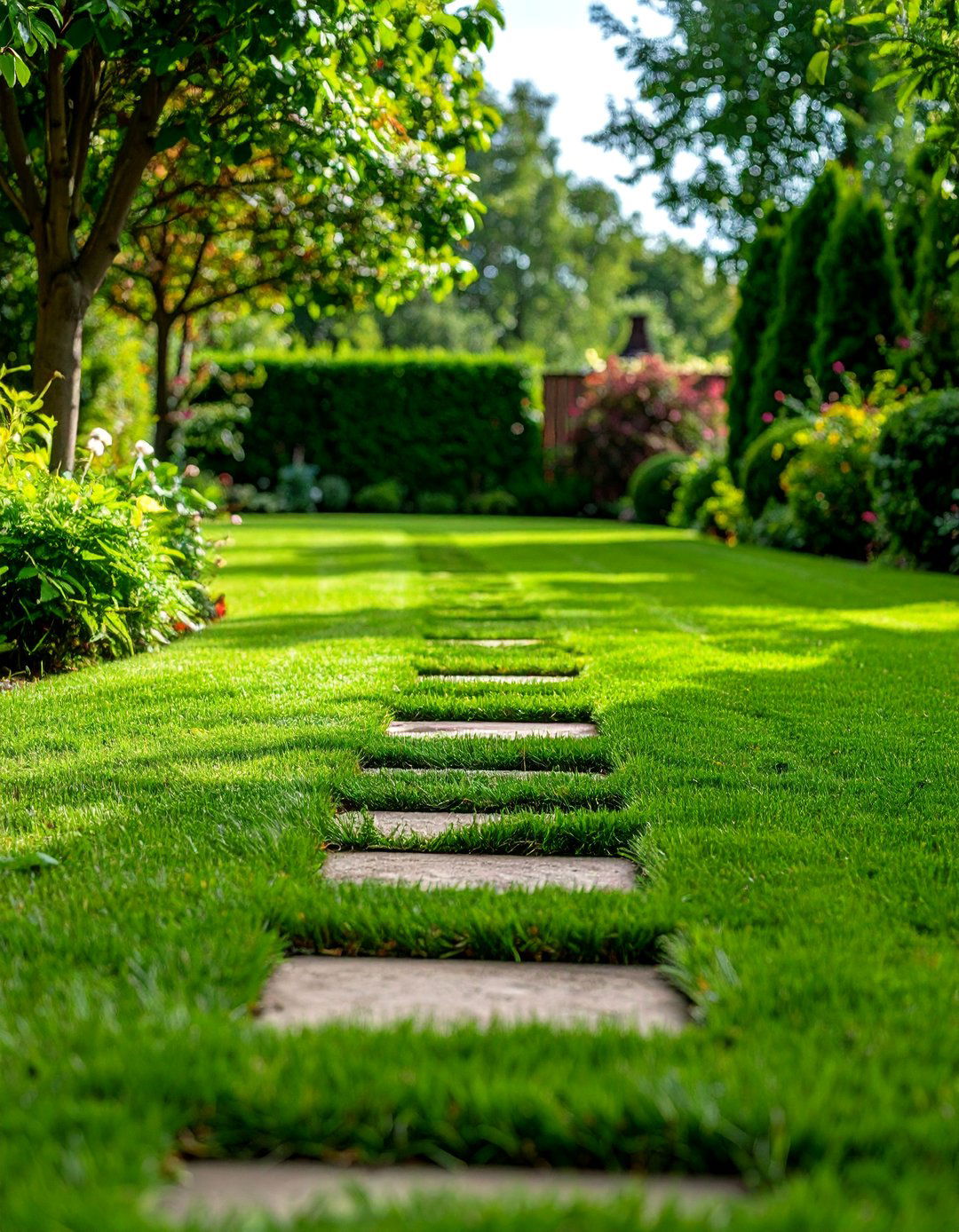
Grass garden paths offer the simplest and most economical approach to creating walkways while maintaining completely natural appearances that blend seamlessly with lawn areas. A soft, mown grass path makes a beautiful secondary route in an informal part of the garden, providing gentle guidance through larger landscape areas. Sometimes the simplest approach can be very effective, such as mowing a pathway through long grassy meadow areas or keeping wide grassy paths flanking long flowering perennial borders. This approach works particularly well in cottage gardens, naturalized areas, or anywhere you want to maintain wild, informal character while providing clear circulation routes. The cheapest materials for garden walkways are grass seeds, sod, and topsoil, involving minimal cost if you can use what's already available in your yard. Maintenance involves regular mowing to maintain definition and occasional overseeding to maintain thick coverage. The natural drainage and flexibility make grass paths excellent choices for areas with seasonal use or changing landscape needs.
20. Contemporary Concrete Garden Path Design

Contemporary concrete garden paths deliver modern sophistication through clean lines, smooth surfaces, and creative finishing techniques that complement minimalist and architectural landscape designs. Contemporary square stepping stone walkways using oversized paving slabs positioned on lush moss beds flanked by beautiful shrubs add modern sophistication to outdoor spaces. Modern concrete techniques allow for various surface treatments including exposed aggregate, stamped patterns, integral coloring, and polished finishes that create custom appearances. Concrete edging is less expensive than brick or stone but offers the same advantages, with newer types that look like random pieces of tumbled stone providing lower-cost alternatives. The versatility of concrete allows for curves, geometric shapes, and integration with other hardscape elements while maintaining consistent material palette. Proper installation includes reinforcement, expansion joints, and appropriate thickness for intended loads. While requiring professional installation for best results, concrete paths provide decades of maintenance-free service with excellent accessibility characteristics. The neutral colors and smooth surfaces highlight surrounding plantings while providing clean, uncluttered circulation routes through contemporary gardens.
Conclusion:
The perfect garden path combines functionality with aesthetic appeal, creating beautiful connections that enhance your landscape's overall design. Whether you choose budget-friendly gravel, elegant flagstone, or sustainable wood materials, each option offers unique benefits suited to different garden styles and maintenance preferences. Consider factors like climate, foot traffic, accessibility needs, and existing landscape elements when making your selection. Remember that paths can evolve over time - starting with simple materials and upgrading gradually as your garden matures. The key is choosing designs that reflect your personal style while serving practical needs, creating walkways that invite exploration and provide years of beautiful, functional service throughout your outdoor living space.


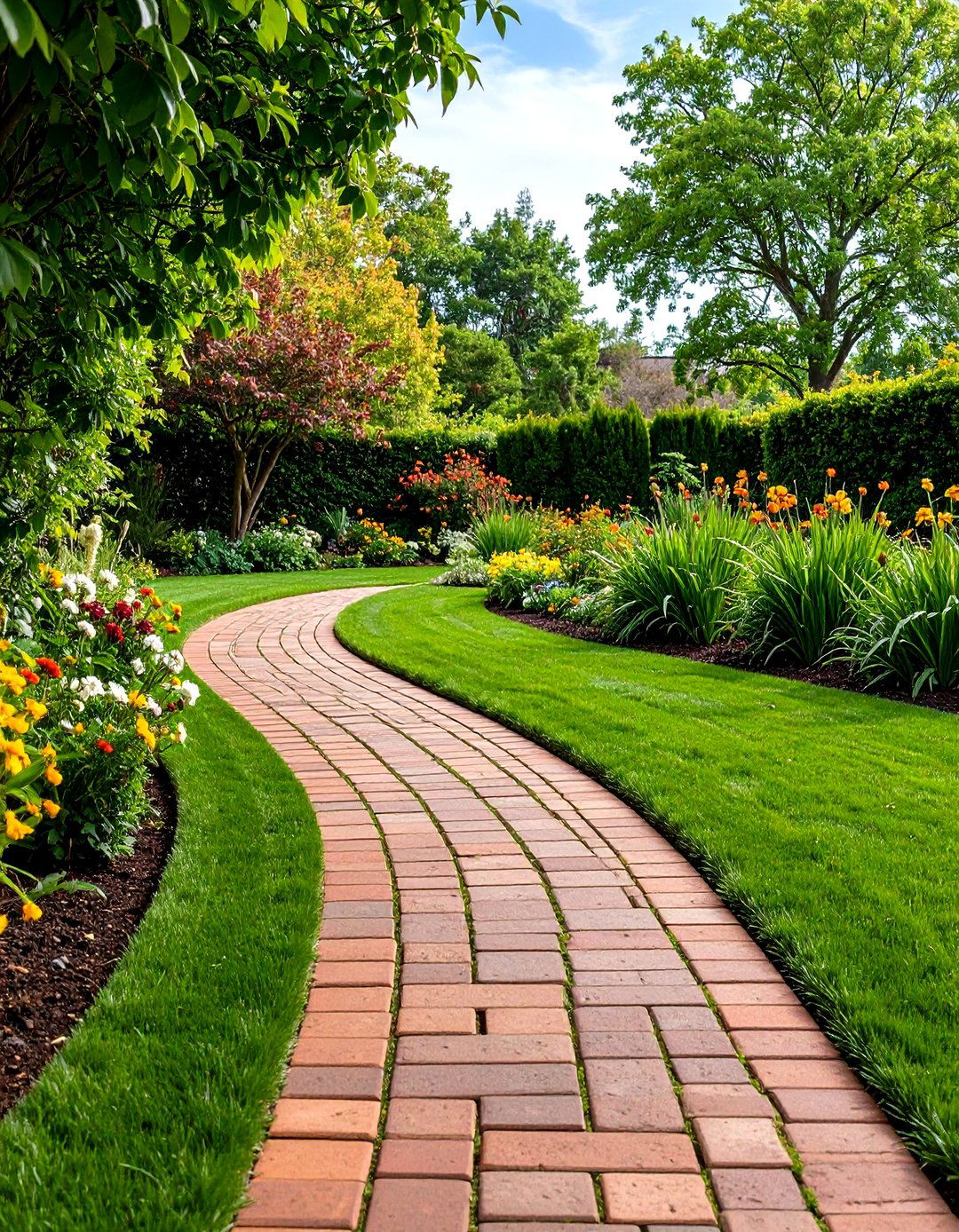
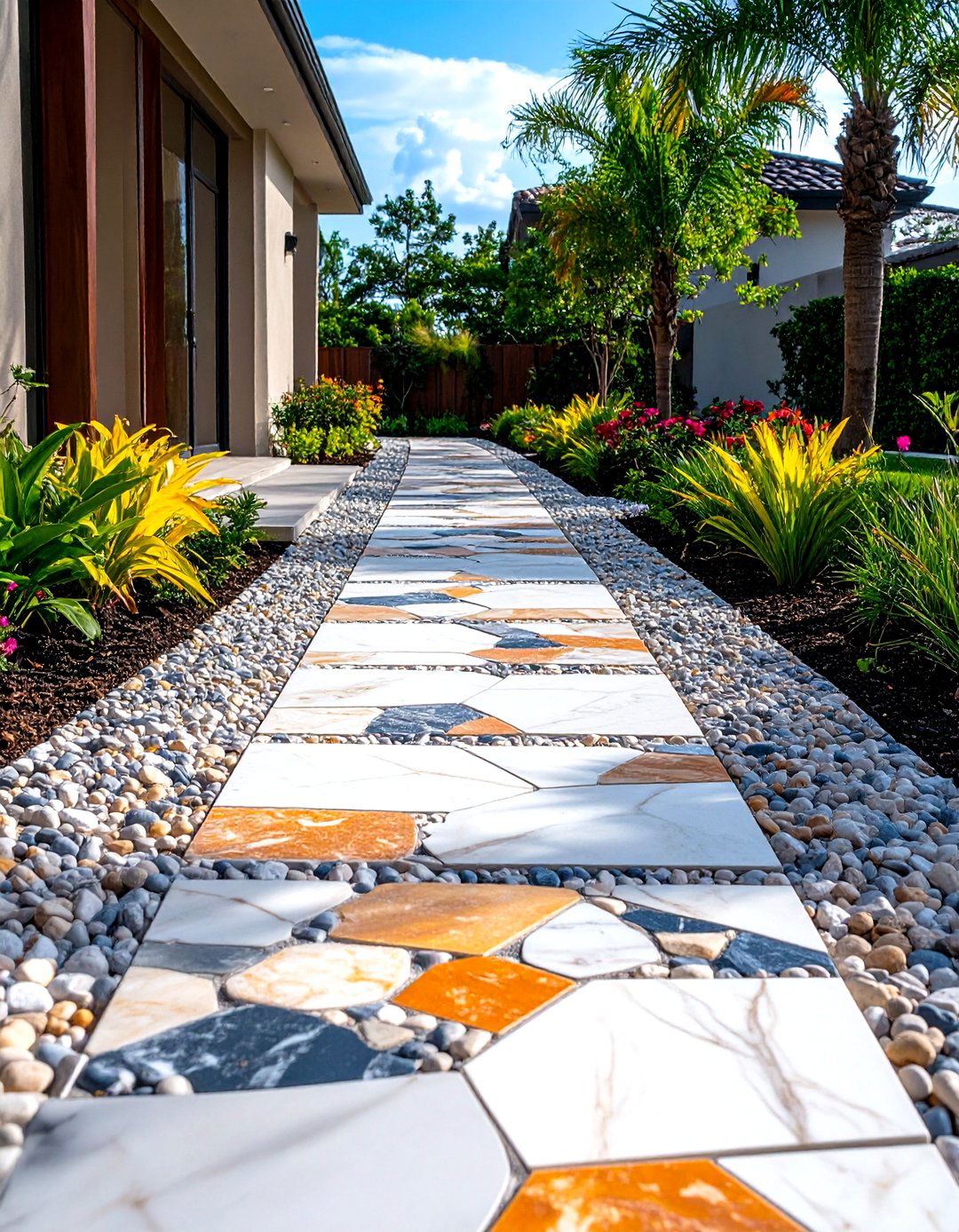



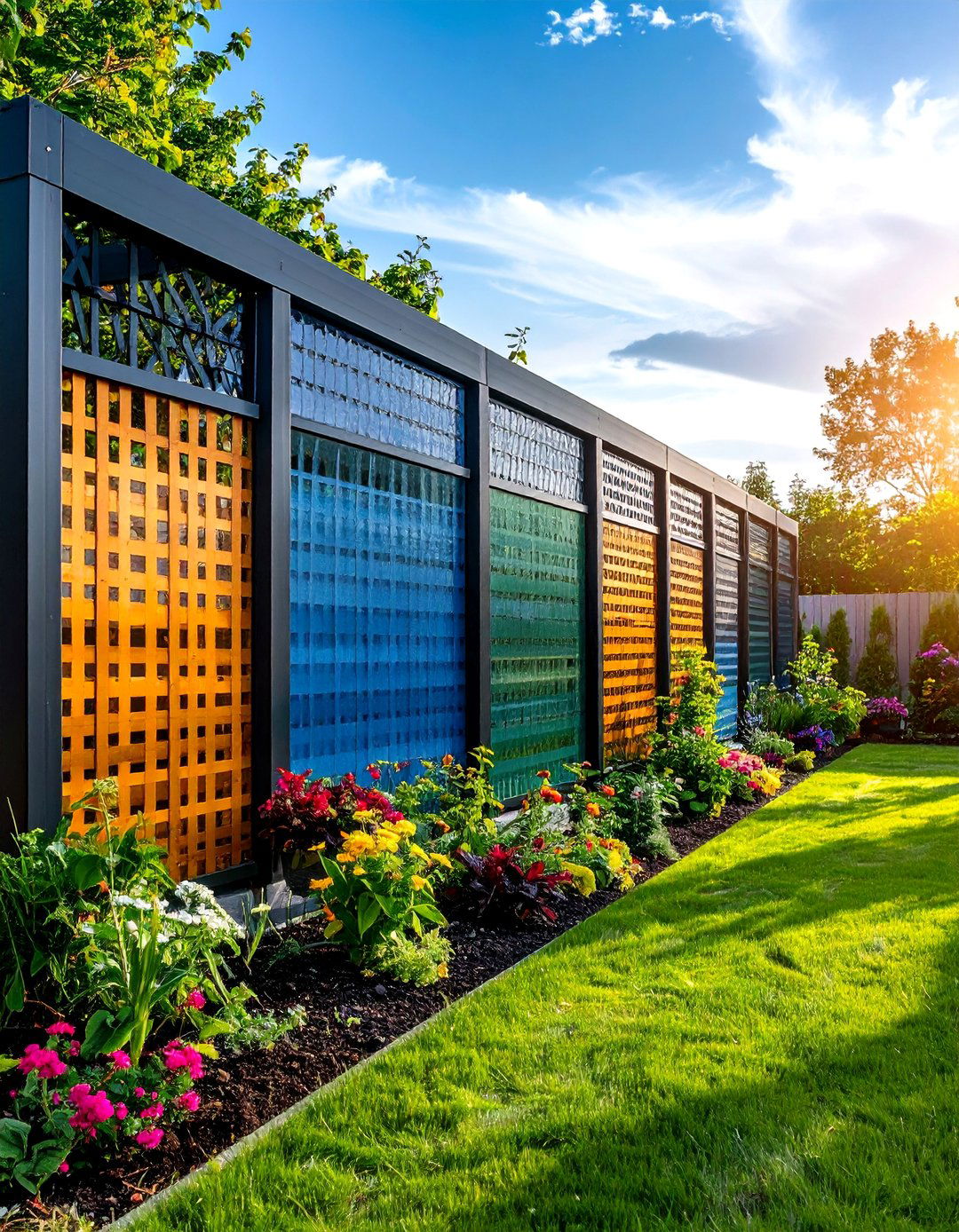
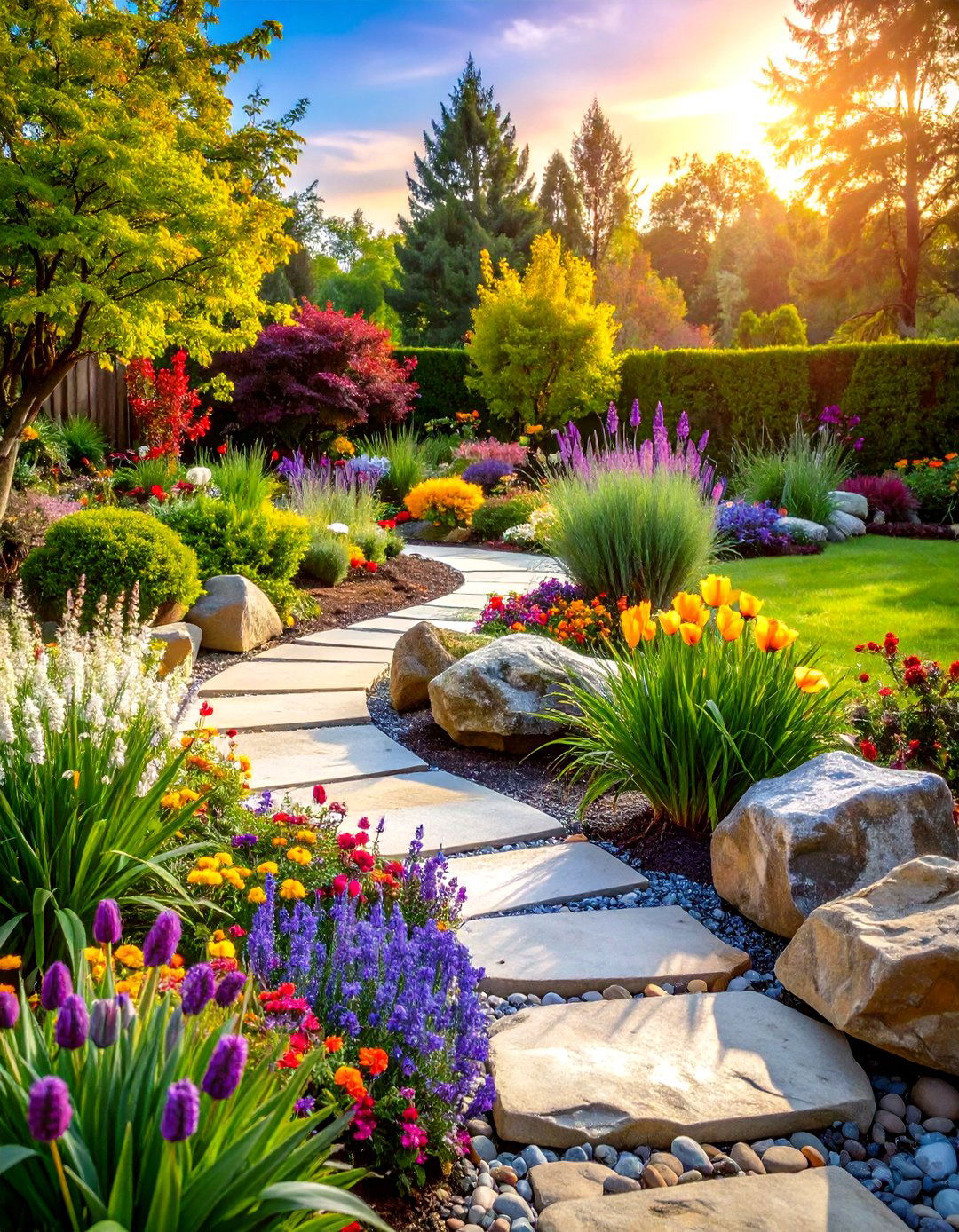
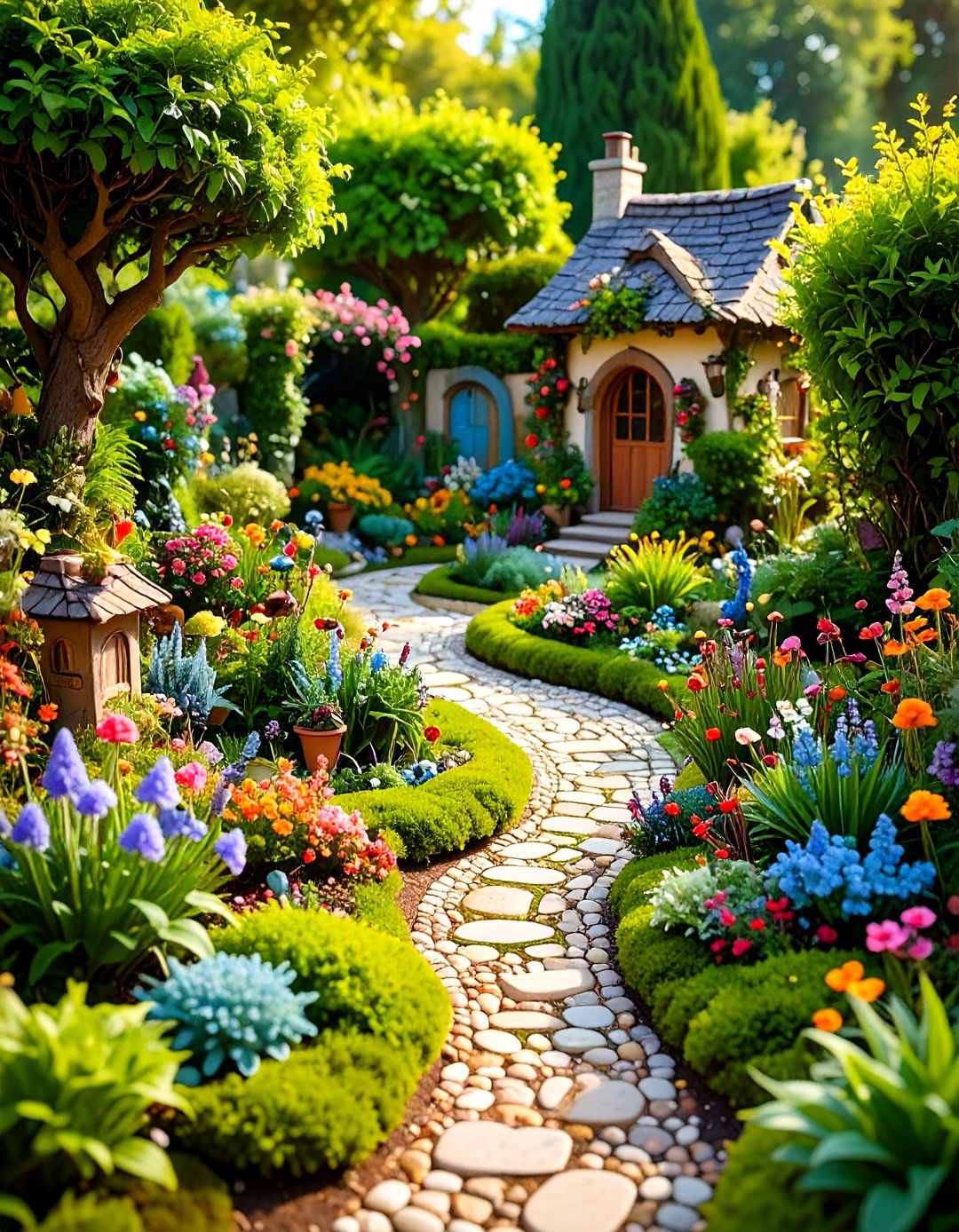


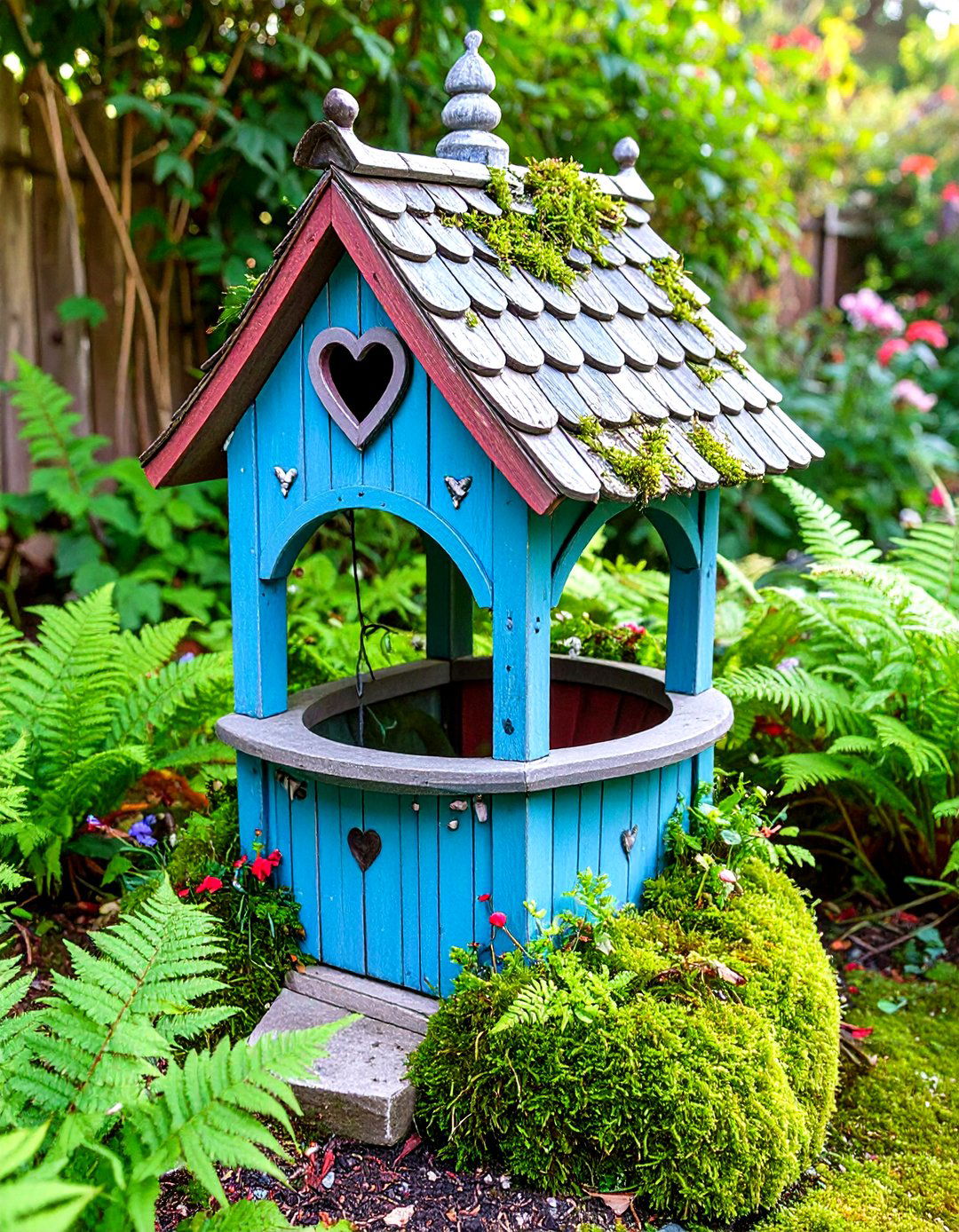

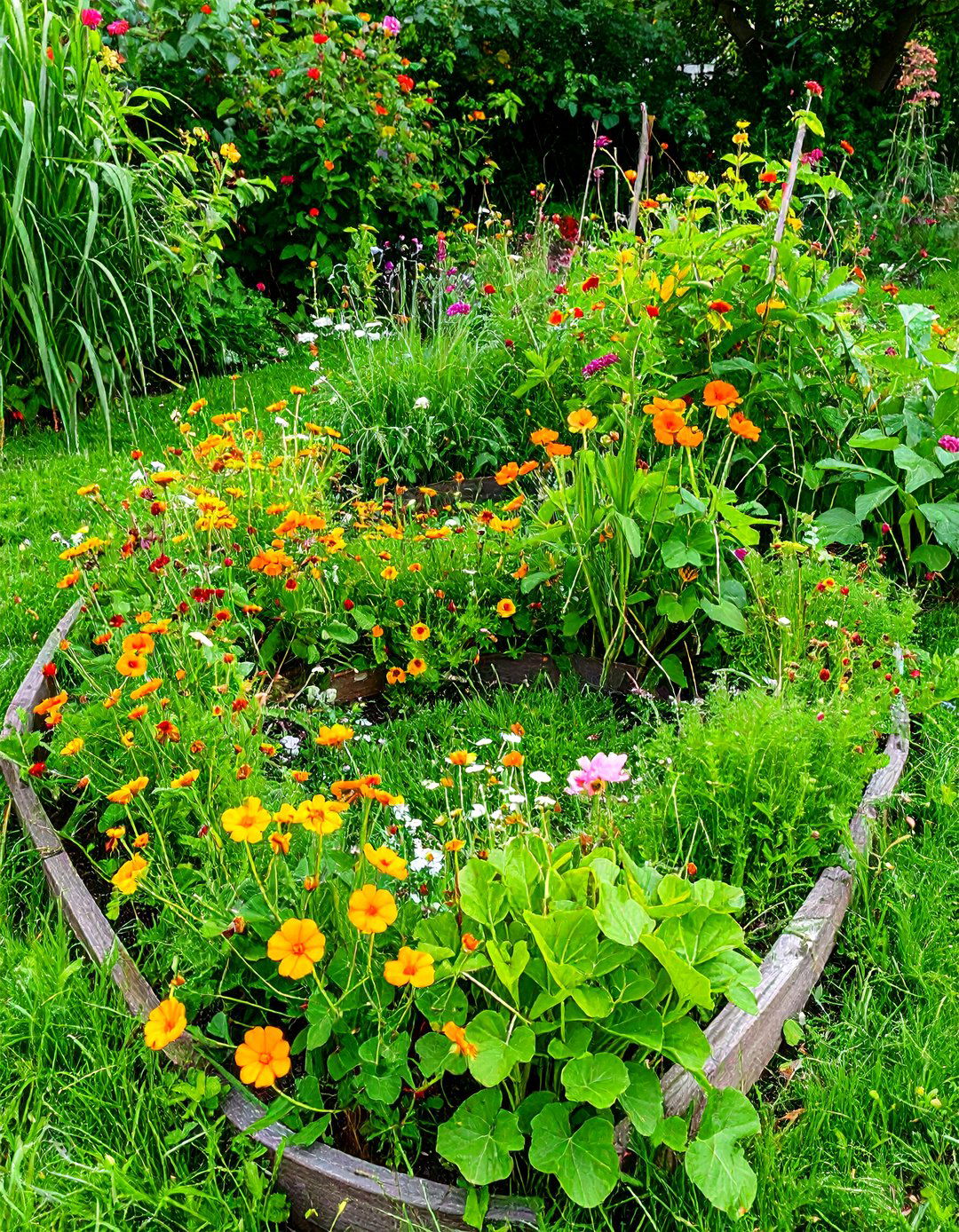
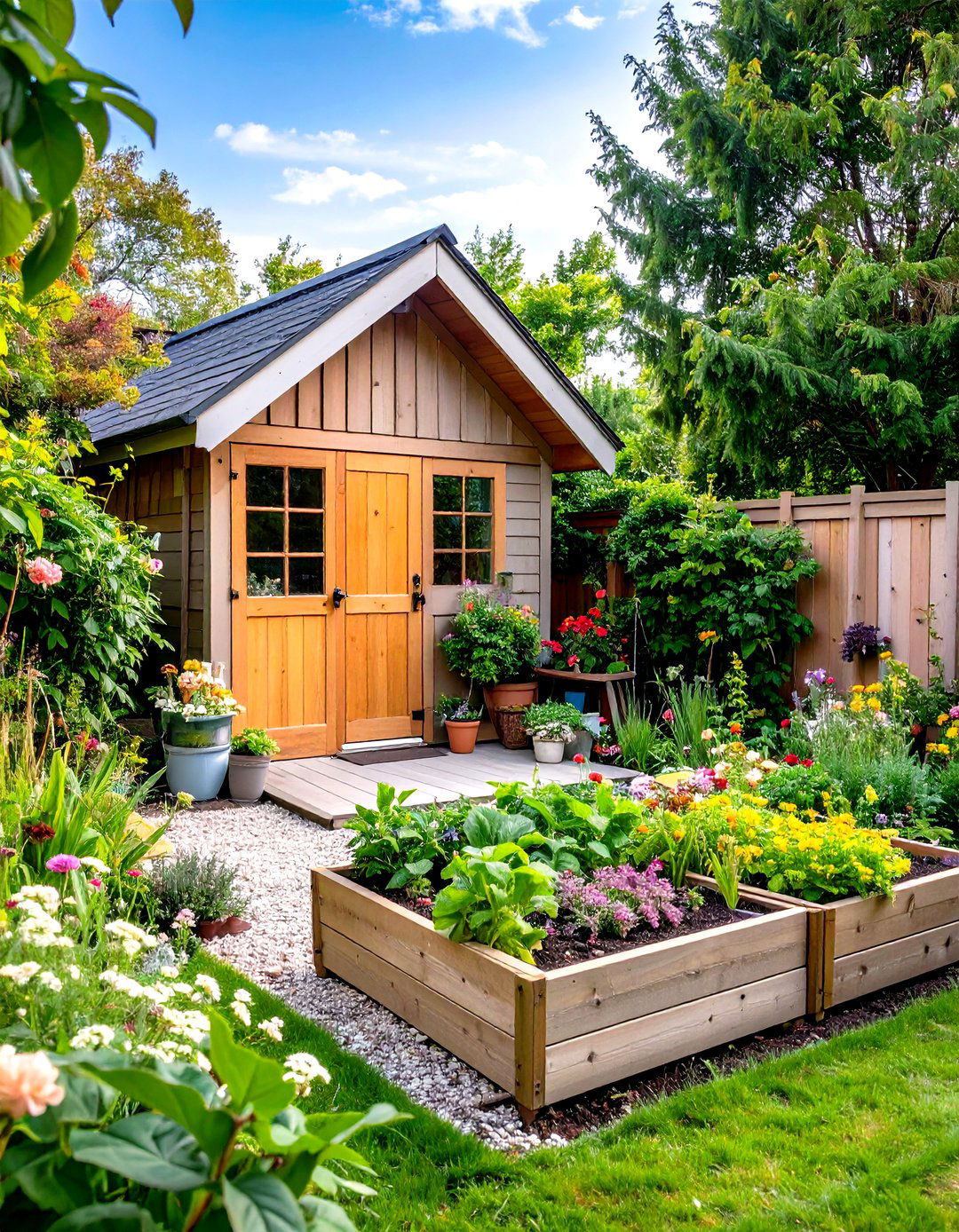
Leave a Reply